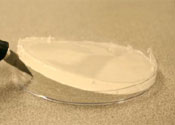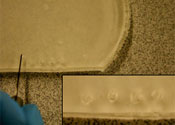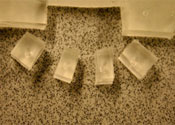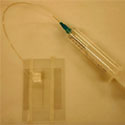Swomitra Mohanty, David J. Beebe
University of Wisconsin Department Biomedical Engineering
Glennys Mensing
University of Illinois Department of Mechanical & Industrial Engineering
Why is this useful?
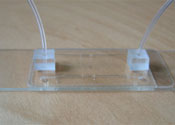 The purpose of this Tip is to show a simple method to connect the microfluidic world to the macro world. Microfluidic devices are constructed from a variety of materials including glass, silicon, and polymers.
The purpose of this Tip is to show a simple method to connect the microfluidic world to the macro world. Microfluidic devices are constructed from a variety of materials including glass, silicon, and polymers.
No matter how microfluidic devices are constructed, one common problem has been employing a user friendly method to connect standard fluidic equipment such as syringes, to the microfluidic device. Often researchers attempt to use commercially available micro-tube fittings by gluing them to ports on a microfluidic device. These fittings are small in size and difficult to work with and the glue can clog the port. To solve this problem we employ an in house fabricated PDMS connector that consists of a hole through the center and uses double-sided adhesive to connect to the microfluidic device.
What do I need?
- PDMS SYLGARD 184 silicone elastomer base & curing agent (Dow Corning)
- 3″ Petri dish
- One utility knife (McMaster Carr Supply Company No.:35575A71)
- Grace Bio-Labs Secure-Seal Adhesive (double sided) (SA-S-1L)
- Whatman 42 filter paper (9 cm Whatman No.:1442-09 )
The purpose of the filter paper is to help bond the PDMS to the double sided adhesive. However the pores in the filter must be large enough for PDMS to penetrate. Pore sizes between 2 -8 µm are appropriate
- One blunt 16 gauge reusable steel needle (Integrated Dispensing Solutions Part # 9991279-2)
The blunt needles are used to core through the PDMS. Care needs to be taken when coring otherwise tears may occur in the hole causing the PDMS connector to leak. The inside of the blunt needle can be sharpened using a round file. Simply insert the file into the tip of the needle and file the inner edge till it is sharp. This will make a cleaner hole through the PDMS.
The size of the needle will depend on the tubing size you are using to connect to your device. Choose a needle size that is slightly smaller than the tubing you are using. The PDMS will flex around the tubing and provide a good seal.
What do I do?
1. Trace Petri dish on adhesive and cut out circle Typically 6 Petri dishes can be traced on a single Grace-Biolabs sheet. The template provided can be used to help cut out circles.
2. Peel off the paper side of the adhesive and place the sticky side onto the filter paper. Apply pressure over the entire area to remove any air bubbles
3. Place the filter/adhesive into the lid of the Petri dish. Make sure the filter paper faces up and that the whole filter/adhesive assembly lies flat against the dish. Do not worry if the edge of the filter/adhesive curls up a little on the side. This will result in thinner PDMS connectors on that side.
Adhesive cicle in petri dish plus uncured PDMS
They will still be functional. Mix 25 g of PDMS with 2.5 g (10%) hardening agent and pour it into the dish (Figure 2). Place on a hot plate at 50 degrees Celsius and cure for 4 h.
4. Remove the dish from the hot plate and let cool for 5 min. Using the knife cut the PDMS around the edges of the dish to loosen it. Then pry the PDMS from the dish (Figure 3).
5. Take the 16 gauge blunt needle and place it on the surface of the PDMS. Turn the needle back and forth while applying pressure to create a through-hole. Make several holes in a row (Figure 4).
6. Take the knife and cut squares around each of the holes. After cutting out the row, each hole can then be separated into individual connectors (Figure 5).
Figure 5.
7. Clean the surface of your microfluidic device with some ethanol. (The surface must be clean for good adhesion.) Peel the adhesive off the bottom of the PDMS connector. This should remove the PDMS core made with the blunt needle. If not, you may need to remove it with fine tweezers.
8. Attach the connector to your microfluidic device. Insert tubing into the connector and attach the other end to a fluidic source such as a syringe (Figure 6).
Figure 6.




